Class 7 Science Chapter 8 Question Answers - Reproduction in Plants
Q1. Mention the benefits of seed dispersal.
Ans: Benefits of Seed Dispersals
- Seed dispersal avoids overcrowding of young plants around their parent plants.
- It helps in preventing competition between the plants and its own seedlings for sunlight, water and minerals.
- One of the benefits of seed dispersal is that it enables the plant to grow into new habitats for wider distribution and provides them with better chance of survival.
Q2. What is seed dispersal? What will happen if all the seeds of a plant were to fall at a same place and grow?
Ans:
- Plant produces large number of seeds. When these seeds fall down they starts growing. The process by which the seeds are scattered to different place (far and wide from their parents) is called seed dispersal.
- The seeds and fruits are dispersed away through various agencies like air, water and animals. Sometimes dispersal takes place by the explosion or bursting of fruits. If all the seeds of a plant were to fall at the same place and grow, there will be a severe competition for sunlight, water, mineral and space.
- As a result, the survival for the plants will be difficult and the plants who survive will not grow into a healthy plants.
Q3. How do the plants like sugarcane, potato and rose reproduce when they cannot produce seeds?
Ans: Sugarcane and rose are propagated by stem cutting that is a method of vegetative propagation, in which stem is capable of growing into a mature independent plants that are identical to their parents.
Potato is an underground modified stem having bud called eyes, which sprout and develop into a new identical plant.
Thus, the plants which cannot produce seeds, can be propagated vegetatively with the help of vegetative parts such as stem, roots, buds and leaves.
Q4. What is meant by the term fertilisation? List the stepwise manner leading to formation of an embryo.
Ans:
- The process in which the male gamete fuses with female gamete to form a new cell (called zygote) is called fertilisation.
- When the pollens are deposited on the stigma of the pistil, it begins to germinate. After sometime, a long pollen tube is developed from the pollen grain which passes through the style towards the female gametes in the ovary. The male gametes move down the pollen tube and the tube enters the ovule present inside the ovary.
- The tip of pollen tube bursts and the male gamete comes out of the pollen tube. Inside the ovary, the male gametes fuse with the female gametes present in the ovule to form a fertilised egg cell which is called zygote.
- The zygote develops into an embryo which is a part of a seed that develops into a new plant.
Q5. Write how the following seeds are dispersed.
(a) Seeds with wings
(b) Small and light seeds.
(c) Seeds with spines/hooks.
Ans: The mode of dispersal of the seeds having following properties are as follows:
(a) Seeds with wings-like seeds of drumstick and maple become light weighted and can be blown away by air. Thus, these are dispersed by wind.
(b) Small and light seeds like seeds of grasses and cotton (having hairy growth) are also dispersed through wind.
(c) Seeds of Xanthium, Urena have spines and hooks on them, these hooks or spines are attached to the fur of the animal body. When animals move to other places and rub their body with tree, etc., these seeds fall from their body and get dispersed.. Therefore, these are dispersed through animals.
Q6. Insects are called agents of pollination. How do they aid in process of pollination?
Ans: Flowers have nectars that attract insects. Insects suck these nectars as their food. When insects like bee, butterfly, etc., sit on the flower for sucking nectar, the sticky pollen grains get attached to their legs and wings. When these insects again sit on another flower, these pollen grains are transferred to the stigma of that flower from the body of the insects. In this way, insects help in pollination.
Q7. Observe the given figure? (a) Which plant is this? Give the name of the plant.
(a) Which plant is this? Give the name of the plant.
(b) What does it shows?
(c) From where the new plants are developing?
Ans:
(a) The given figure is of Bryophyllum leaf. It is also called as sprout leaf plant.
(b) It shows vegetative reproduction by leaves.
(c) The leaves of Bryophyllum develops some buds in its margin or edges which grow into new plants, when buried in the soil.
Q8. Describe the structure of a flower.
Ans: The main parts of a flower are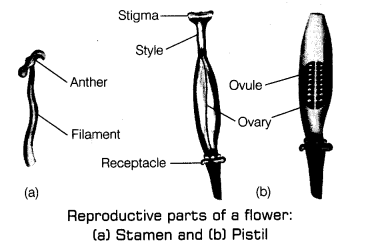
(i) Sepals: These are the green leaf-like outermost circle of the flower. All the sepals are together referred to as calyx. The function of calyx is to protect the flower when it is in bud form.
(ii) Petals: These are the colourful and most attractive part of flower. These lie inside the sepals. All the petals are together referred to as corolla. These are scented and attract insects for pollination.
(iii) Stamen: It is a male reproductive organ of plant. These are the little stalks with swollen top and lies inside the ring of petals. The stamen is made up of two parts, i.e. filament and anther. The stalk of stamen is called filament and the swollen top of stamen is called anther.
Anther contains the pollen grain which have male gamete in it. Pollen grains are exposed when the anther ripens and splits. These appear as the yellow powder like substance which is sticky in nature. Flowers usually have a number of stamens in it.
(iv) Pistil: It is the female reproductive part of a flower that lies in the centre of a flower. These are flask-shaped structure which is made up of three parts, i.e. stigma, style and ovary.
The top part of pistil is called stigma. It receives the pollen grains from the anther during pollination. The middle part of the pistil is tube-like structure called style which connects stigma to the ovary.
The swollen bottom part at the base of pistil is called ovary.
The ovary makes ovules and stores them. These ovules contain the female sex cells also called as egg cell. It is the female gamete of flower. Pistil is also called as carpel. The pistil is surrounded by several stamens.
The base of the flower on which all the parts of flower are attached is called receptacle.
Q9. Explain the process of reproduction in plants, involving the fusion of cells from male and female parts of a flower.
Ans: When the reproduction in an organism includes two types of gametes, i.e male and female from two different parents, it is called sexual reproduction. The sexual reproduction takes place by the fusion of male and female gametes by the process called fertilisation to form zygote.
Sexual reproduction [fertilisation) in plants The different steps that take place during sexual reproduction in plants are
- The pollens are deposited on stigma and begins to germinate.
- Pollen tube containing male gametes reaches to the ovary of flower.
- The tip of the pollen tubes gets dissolved and male gametes comes out of the pollen tube.
- Inside the ovary male gametes fuse with the female gamete or egg present in the ovule.
- The fusion of both the gametes will result into a fertilised egg cell which is also called as zygote.
Q10. Observe the given figure and answer the following questions.
(a) Name the plant?
(b) Which type of reproduction is seen in this plant?
(c) Is ginger a root or stem?
(d) Label the part of this plant?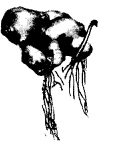 Ans:
Ans:
(a) The given figure is of ginger tuber.
(b) Asexual reproduction is seen in this plant.
(c) Ginger is a stem.
(d) Various parts of this plant can be shown as follows: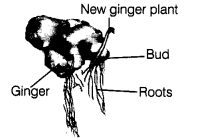
Q11. Observe the following figure and answer the following questions.
(a) Which type of vegetative propagation has been shown in this figure?
(b) Name two plants where this method of vegetative reproduction takes place.
(c) Is this a sexual or asexual mode of reproduction?
(d) Label the part (A) and (B) in the given figure.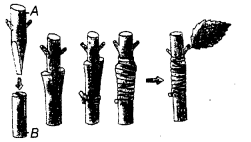
Ans:
(a) The given figure shows grafting method (vegetative reproduction).
(b) Mango and rose are the two plants where this method of vegetative takes place.
(c) It is asexual method of reproduction.
(d) (A) Scion (B) Stock
Q12. Name some fruit bearing plants. Now make a table and describe the method of seed dispersal in these fruits as well as the part which helps in the seed dispersal.
Ans: The method of seed dispersal in the fruits and the parts which help in the seed dispersal:
Name of fruits bearing plants Agents through which seeds are dispersd Parts or seeds which helps in dispersal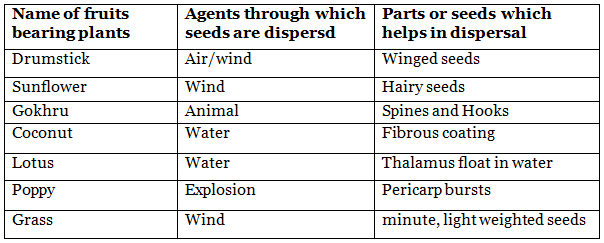
Q13. How many types of reproduction are there in plants? Explain.
Ans: There are two types of reproduction in plants:
- Sexual reproduction
- Asexual reproduction
(i) Sexual reproduction; The mode of reproduction in which new plants are produced from seeds by involvement of both male and female gametes.
(ii) Asexual reproductions In this mode of reproduction, new plants are produced without seeds by involvement of single parent.
Q14. What is budding? Explain with an example.
Ans: The process of formation of an additional outgrowth, as bud, which gets detached from the parent cell to produce new individual is called budding. For example, the yeast grows asexually by process of budding. The small bulb like projection coming out from the yeast cell is called bud. It gradually grows and gets detached from the parent cell and forms a new yeast cell. Sometimes, another bud arises from the bud forming a chain of buds.
Q15: Explain reproduction through spore formation.
Ans: Reproduction through spore formation is a type of asexual reproduction. Spores are small spherical bodies covered with a protective coat. The coat protects the spore from unfavourable conditions. The coat burst and spore germinate into new plants when the conditions are favourable. The fungi on a bread piece grow from spore which are present in the air. Plants such as moss and fern also reproduce by means of spores.
Q16. Define two types of flowers with examples.
Ans: Flowers are the reproductive parts of a plant. There are two types of flowers-
- unisexual and
- bisexual flowers.
The flowers which contain either only the pistil or only the stamens are called unisexual flowers, e.g., corn and papaya. On the other hand, the flowers which contain both stamens and pistil are called bisexual flowers, e.g., mustard and rose.
Q17. What is pollination? Explain self-pollination and cross-pollination with the help of a diagram.
or
What is pollination? Explain types of pollination.
Ans:
The transfer of a pollen from the anther to the stigma of a flower is called pollination.
There are two types of pollination:
(i) Self-pollination
(ii) Cross-pollination
When the pollen lands on the stigma of the same flower, it is called self-pollination [Fig(a)]. It takes place in a bisexual flower.
When the pollen of a flower lands on the stigma of another flower of the same plant, or that of a different plant of the same kind, it is called cross-pollination [Fig(b)]. It takes place in either unisexual or bisexual flowers. The petals of cross-pollinated flowers are generally brightly-coloured to attract insects towards it.
Q18. Explain the reproductive parts of a flower with a labelled diagram.
Ans: Flowers are the reproductive parts of a plant. The stamens are the male reproductive part and the pistil is the female reproductive part (Fig.). Anther contains pollen grains which produce male gametes. A pistil consists of stigma, style and ovary. The ovary contains one or more ovules. The female gamete or the egg is formed in an ovule. In sexual reproduction a male and a few female gamete fuse to form a zygote.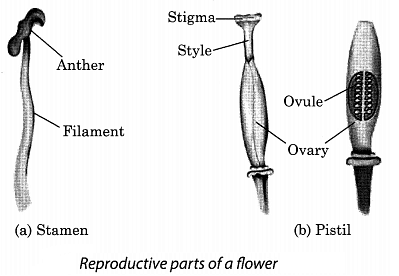
Q19. What is vegetative propagation? Describe vegetative propagation through different parts of the plant.
Ans: The type of asexual reproduction in which new plants are produced from vegetative parts such as roots, stems, leaves and buds is called vegetative propagation.
(i) Vegetative propagation by roots: The roots of some plants like sweet potato and Dahlia, etc., give rise to new plants [Fig.(a)]
(ii) Vegetative propagation by stems: In some plants like potato, ginger, etc., new plants grow from the stems of these plants. Potatoes have small ‘eyes’ or scars on them which germinates to give rise to new plants. Similarly small bud produce new plants in ginger and turmeric [Fig.(b)]
(iii) Vegetative propagation by leaves: In some plants, new plants grow from the margins of the leaves, e.g., in Byrophyllum small plantlets grow from the margins of the leaves. These plantlets when get detached from the leaves develops into an independent plant. [Fig.(c)]
Q20. Explain zygote formation or fertilisation with the help of a diagram.
Ans: In sexual reproduction, a male and female gamete fuse to form a zygote. This process of fusion of gametes to form a zygote is called fertilisation (Fig.). The zygote develops into an embryo.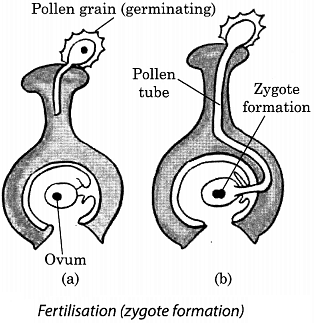
|
112 videos|286 docs|28 tests
|





















